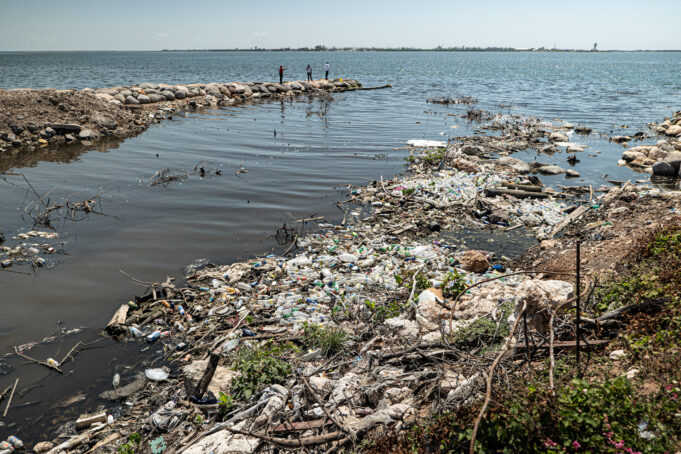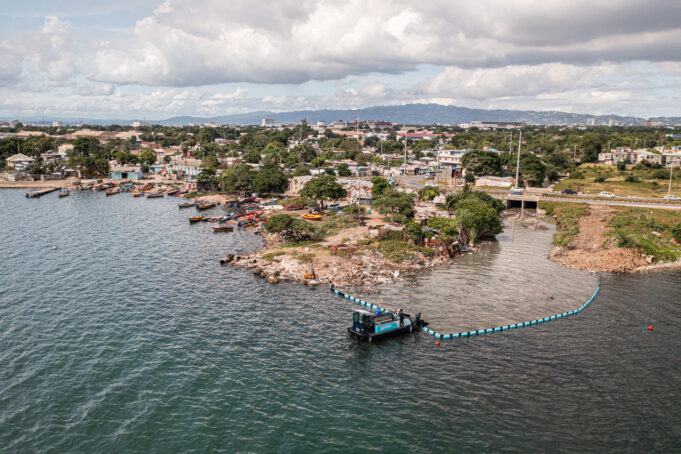Kingston Harbour, Jamaica
Project lead: The Ocean Cleanup
Introduction
Kingston Harbour, the seventh largest natural harbor in the world, lies along the southern coast of Jamaica and includes the shoreline of Kingston, Jamaica. Fresh water, along with various industrial and domestic waste, is discharged into Kingston Harbour and adjacent Hunts Bay from rivers and drainage gullies, including Rio Cobre and Sandy Gully. The Rio Cobre is one of the largest rivers in Jamaica, with an approximate drainage area of 646 km². The Sandy Gully is part of the city drainage system, emptying into a large area in the upper section of the Kingston metropolitan area, carrying urban runoff into Hunts Bay. Recently, solid waste clogging the gullies has become a significant concern in Kingston. Gullies blocked by debris have resulted in localized flooding and damage to infrastructure. Additionally, rubbish is starting to accumulate in the mangrove forests – creating banks high enough to affect the seawater exchange in and out of the system. Inadequate circulation also results in stagnation or hyper salinity or both, affecting the flora and fauna of the mangroves. Pollution from these waterways travels far offshore and threatens coral reefs in the Caribbean. Coral reefs are one of the most threatened ecosystems on the planet and one of the most important. While they make up less than 0.1% of the ocean, coral reefs are home to more than 25% of the total biodiversity in the sea. They protect coastal communities from storms and erosion, provide food and medicine, and are essential drivers of ecotourism.


Intervention Plan
The Ocean Cleanup plans to clean the eleven main drainage gullies that cause waste contamination in the Kingston Harbour. The harbor includes Hunts Bay, at the mouth of the Cobre River, and the two major drainage gullies, Jew Gully and Sandy Gully, plus eight additional gullies. To meet the specific conditions of these waterways, The Ocean Cleanup is deploying a newly developed technology, referred to as the Interceptor Barrier, at the gullies’ mouths. During wet seasons, the Barrier will contain the waste at the mouth of the gullies, allowing for effortless extraction using the Interceptor Tender vessel, a modified version of Berky’s Weed Harvester. During the dry seasons, manual cleanups along the gullies will be part of the outreach program.
The work will be conducted in two phases: Phase 1 is a test pilot encompassing the installation of three Interceptor Barriers at three gullies. An Interceptor Tender will service each Barrier. Upon completion of a successful testing period, Phase 2 will commence with installing Barriers at the eight remaining gullies. It is anticipated that the deployment of additional waste extraction capacity will be added in 2022. At the end of Phase 2, The Ocean Cleanup estimates extracted waste from all eleven gullies to amount to more than 900 metric tons per year.
Waste Collection and Sorting
Captured waste will be separated at collection centers in Kingston. Plastic debris will be identified, with PET and HDPE items separated, baled, and sold for recycling. The plastic waste will then be processed into washed flakes offered for sale on the open market. In the first phase of the project, debris that cannot be recycled will be dried and transported to the nearby landfill. In the second phase, collected waste may be pre-processed in the cement plant in Kingston for eventual thermal recycling.

Community Engagement
The Ocean Cleanup is partnering with the GraceKennedy Foundation, which will oversee all community engagement, emphasizing outreach to local youth. To raise awareness about the consequences and prevention of marine litter in the gullies, the Foundation plans to target various age groups in the downtown and uptown local communities (areas where much of the waste in the gullies originates).
Given the limited access to school grounds as a consequence of the COVID-19 pandemic, the GraceKennedy Foundation will reach out to the youth through school activities and homeschooling platforms, as well as through local youth organizations. To engage these communities, the GraceKennedy Foundation will align with community leaders who are familiar with its work. Once the separation center at the extracted waste offload site has been set up, invitations to visit may be extended to schools and local communities. They will also continue to explore additional ways to reach the target audiences.
Since the gullies run dry during roughly six months of the year, outreach programming will also include community engagement for manual cleanup campaigns with the help of local volunteers.
The Team
 The Ocean Cleanup is a non-profit organization based in the Netherlands. The organization develops and scales technologies to rid the world’s oceans of plastic. To fulfill its mission, The Ocean Cleanup is not only addressing the legacy problem of what’s already in the ocean but is also working to prevent additional plastic from entering the ocean via river cleanup interventions.
The Ocean Cleanup is a non-profit organization based in the Netherlands. The organization develops and scales technologies to rid the world’s oceans of plastic. To fulfill its mission, The Ocean Cleanup is not only addressing the legacy problem of what’s already in the ocean but is also working to prevent additional plastic from entering the ocean via river cleanup interventions.
The GraceKennedy Foundation is associated with the GraceKennedy Group, one of the Caribbean’s largest food and financial entities established first in Jamaica. Its mission is to build environmentally sustainable programs, promote healthy lifestyles and increase access to education. As a trusted brand with strong local community ties, the GraceKennedy Foundation is currently leading an outreach program to protect the mangroves in the Kingston Harbor from waste accumulation and plastic pollution. The Foundation’s track record and experience with similar outreach programs make them a strong partner for conducting outreach in connection with this project.
Recycling Partners of Jamaica (RPJ) envisions the development and maintenance of a sustainable plastic recycling system within an engaged Jamaica. To this end RPJ’s primary mission is to develop and support the recycling industry by providing and maintaining adequate infrastructure, increasing employment through entrepreneurship and engaging the public, private and governmental sectors in sustained best practices for waste management. RPJ is the designated national recycling entity by the Government of Jamaica with the mandate to remove plastic bottles from the environment by engaging the public, businesses, and schools to divert plastic from landfills.
The core function of Clean Harbours Jamaica is the dynamic and systematic cleanup and restoration of natural harbours and gullies and streams. Their mission is to provide cleaner oceans across the island of Jamaica and have targeted focus on the Kingston Harbour as a pilot project.

Resources
- The Ocean Cleanup’s website: https://theoceancleanup.com/
- Lourens J. J. Meijer et al. (2021) “More than 1000 rivers account for 80% of global riverine plastic emissions into de ocean”: https://advances.sciencemag.org/content/7/18/eaaz5803


